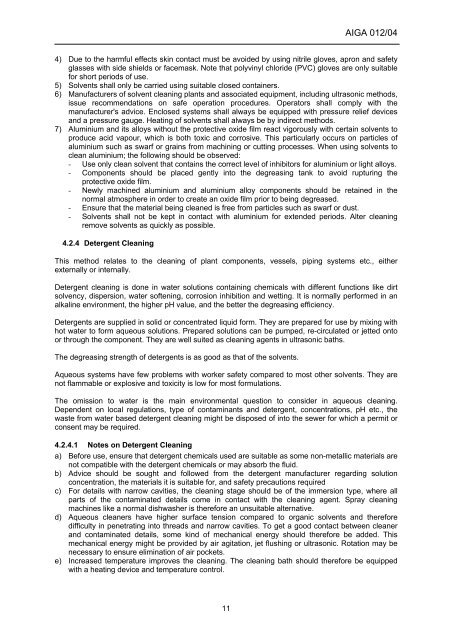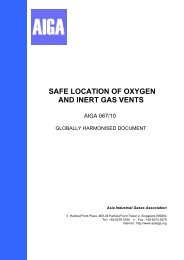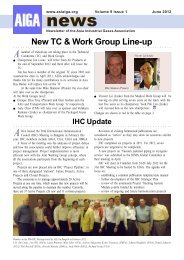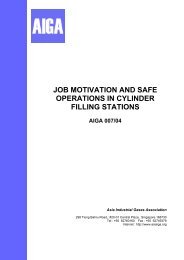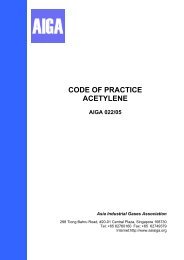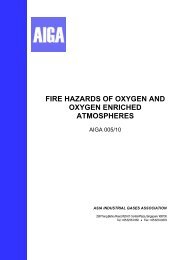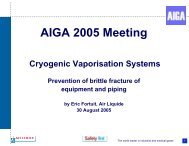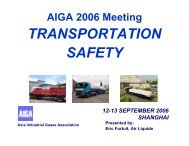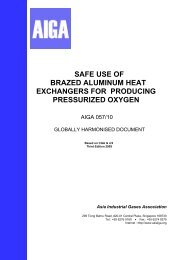CLEANING OF EQUIPMENT FOR OXYGEN SERVICE - AIGA
CLEANING OF EQUIPMENT FOR OXYGEN SERVICE - AIGA
CLEANING OF EQUIPMENT FOR OXYGEN SERVICE - AIGA
You also want an ePaper? Increase the reach of your titles
YUMPU automatically turns print PDFs into web optimized ePapers that Google loves.
11<br />
<strong>AIGA</strong> 012/04<br />
4) Due to the harmful effects skin contact must be avoided by using nitrile gloves, apron and safety<br />
glasses with side shields or facemask. Note that polyvinyl chloride (PVC) gloves are only suitable<br />
for short periods of use.<br />
5) Solvents shall only be carried using suitable closed containers.<br />
6) Manufacturers of solvent cleaning plants and associated equipment, including ultrasonic methods,<br />
issue recommendations on safe operation procedures. Operators shall comply with the<br />
manufacturer's advice. Enclosed systems shall always be equipped with pressure relief devices<br />
and a pressure gauge. Heating of solvents shall always be by indirect methods.<br />
7) Aluminium and its alloys without the protective oxide film react vigorously with certain solvents to<br />
produce acid vapour, which is both toxic and corrosive. This particularly occurs on particles of<br />
aluminium such as swarf or grains from machining or cutting processes. When using solvents to<br />
clean aluminium; the following should be observed:<br />
- Use only clean solvent that contains the correct level of inhibitors for aluminium or light alloys.<br />
- Components should be placed gently into the degreasing tank to avoid rupturing the<br />
protective oxide film.<br />
- Newly machined aluminium and aluminium alloy components should be retained in the<br />
normal atmosphere in order to create an oxide film prior to being degreased.<br />
- Ensure that the material being cleaned is free from particles such as swarf or dust.<br />
- Solvents shall not be kept in contact with aluminium for extended periods. Alter cleaning<br />
remove solvents as quickly as possible.<br />
4.2.4 Detergent Cleaning<br />
This method relates to the cleaning of plant components, vessels, piping systems etc., either<br />
externally or internally.<br />
Detergent cleaning is done in water solutions containing chemicals with different functions like dirt<br />
solvency, dispersion, water softening, corrosion inhibition and wetting. It is normally performed in an<br />
alkaline environment, the higher pH value, and the better the degreasing efficiency.<br />
Detergents are supplied in solid or concentrated liquid form. They are prepared for use by mixing with<br />
hot water to form aqueous solutions. Prepared solutions can be pumped, re-circulated or jetted onto<br />
or through the component. They are well suited as cleaning agents in ultrasonic baths.<br />
The degreasing strength of detergents is as good as that of the solvents.<br />
Aqueous systems have few problems with worker safety compared to most other solvents. They are<br />
not flammable or explosive and toxicity is low for most formulations.<br />
The omission to water is the main environmental question to consider in aqueous cleaning.<br />
Dependent on local regulations, type of contaminants and detergent, concentrations, pH etc., the<br />
waste from water based detergent cleaning might be disposed of into the sewer for which a permit or<br />
consent may be required.<br />
4.2.4.1 Notes on Detergent Cleaning<br />
a) Before use, ensure that detergent chemicals used are suitable as some non-metallic materials are<br />
not compatible with the detergent chemicals or may absorb the fluid.<br />
b) Advice should be sought and followed from the detergent manufacturer regarding solution<br />
concentration, the materials it is suitable for, and safety precautions required<br />
c) For details with narrow cavities, the cleaning stage should be of the immersion type, where all<br />
parts of the contaminated details come in contact with the cleaning agent. Spray cleaning<br />
machines like a normal dishwasher is therefore an unsuitable alternative.<br />
d) Aqueous cleaners have higher surface tension compared to organic solvents and therefore<br />
difficulty in penetrating into threads and narrow cavities. To get a good contact between cleaner<br />
and contaminated details, some kind of mechanical energy should therefore be added. This<br />
mechanical energy might be provided by air agitation, jet flushing or ultrasonic. Rotation may be<br />
necessary to ensure elimination of air pockets.<br />
e) Increased temperature improves the cleaning. The cleaning bath should therefore be equipped<br />
with a heating device and temperature control.


